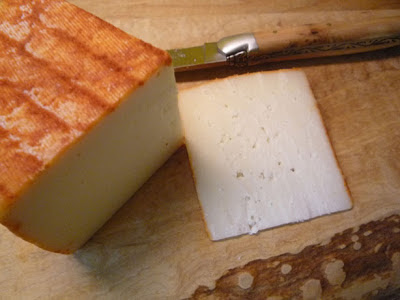Lord of the Hundreds is an award-winning, firm, raw
sheep's milk cheese, produced by The Traditional
Cheese Dairy in East Sussex in South East England.
Lord of the Hundreds was originally
created by James and Pat Aldridge of the Eastside Cheese
Company at Oxted in Surrey, England. James
Aldridge was a key figure in the resurrection of farmhouse cheese-making in
England in the 1980s and 90s.
The name "Lord of The
Hundreds” originates from Saxon times. This Lord, who controlled an area of
land divided into 100 shires, was responsible to collect the taxes from the
locals for the King. A marker denoting
the spot where people would come to pay their dues to the Lord was located
behind James Aldridge's house.
Lord of the Hundreds is made from the raw milk of Friesland ewes
provided by Boydells Dairy Farm in
north Essex. When making this cheese, after the curds have formed, they are
ladled into square baskets. The cheese is not pressed; when making the cheese,
the excess whey is drained under its own weight, forcing out the sides of the
baskets giving the cheese its unique textured rind and shape. Each tomme (or
wheel) is brined and turned every day to distribute the moulds evenly and
encourage the rind to develop. Lord of the Hundreds has an affinage period of 6
to 8 months minimum. The tomme measures approx. 18 cm (7") square and
weights from 4 to 4.5 kg (8 - 10lbs).
Lord of the Hundreds has a light grayish-yellow coloured, rough textured rind, with a golden yellow coloured paste that deepens to an amber colour on the edges near the rind. The dense firm paste has a dry, grainy, slightly crumbly texture. Lord of the Hundreds is a complex cheese with a great balance of both savoury and sweet; light notes of grass, roasted hazelnuts and salty caramel. A tomme that has aged longer has a harder paste and a more robust flavour.
Lord of the Hundreds pairs well with a wide variety of foods and
drinks. Try it with fresh figs; serve it with membrillo (quince paste), dates
and/or pears. Pair it with a crisp, grassy white wine or a medium-bodied
Pinot-Noir or Spanish Tempranillo.
Lord of the Hundreds is the winner of numerous cheese awards. It
received both Gold and Silver medals at The
British Cheese Awards from 2008 to 2012. It recently received the Bronze
medal at the 2014 World Cheese Awards.
The Traditional Cheese Dairy has
developed and refined its range of artisan cheeses over the past ten years;
from the traditional farmhouse Broad Oak Cheddar, to Olde Sussex a traditional
hard British farmhouse cheese, to the delicate taste of another award-winning,
semi-soft washed-rind Burwash Rose. All their cheeses are
made using traditional methods and only always from raw milk.
Photo source: http://kentandsussexguide.com/
Photo source: http://www.eastfriesians.com.au/











































